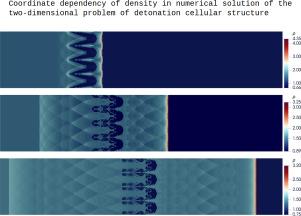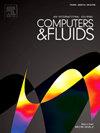Space–time adaptive ADER-DG finite element method with LST-DG predictor and a posteriori sub-cell ADER-WENO finite-volume limiting for multidimensional detonation waves simulation
IF 2.5
3区 工程技术
Q3 COMPUTER SCIENCE, INTERDISCIPLINARY APPLICATIONS
引用次数: 0
Abstract
The space–time adaptive ADER–DG finite element method with LST–DG predictor and a posteriori sub–cell ADER–WENO finite–volume limiting was used for simulation of multidimensional reacting flows with detonation waves. The presented numerical method does not use any ideas of splitting or fractional time steps methods. The modification of the LST–DG predictor has been developed, based on a local partition of the time step in cells in which strong reactivity of the medium is observed. This approach made it possible to obtain solutions to classical problems of flows with detonation waves and strong stiffness, without significantly decreasing the time step. The results obtained show the very high applicability and efficiency of using the ADER–DG– method with a posteriori sub–cell limiting for simulating reactive flows with detonation waves. The numerical solution shows the correct formation and propagation of ZND detonation waves. The structure of detonation waves is resolved by this numerical method with subcell resolution even on coarse spatial meshes. The smooth components of the numerical solution are correctly and very accurately reproduced by the numerical method. Non–physical artifacts of the numerical solution, typical for problems with detonation waves, such as the propagation of non–physical shock waves and weak detonation fronts ahead of the main detonation front, did not arise in the results obtained. The results of simulating rather complex problems associated with the propagation of detonation waves in significantly inhomogeneous domains are presented, which show that all the main features of detonation flows are correctly reproduced by this numerical method. It can be concluded that the space–time adaptive ADER–DG– method with LST–DG predictor and a posteriori sub–cell ADER–WENO finite–volume limiting is perfectly applicable to simulating fairly complex reacting flows with detonation waves.

带有 LST-DG 预测器和后验子单元 ADER-WENO 有限体积限制的时空自适应 ADER-DG 有限元法用于多维爆轰波模拟
采用带有 LST-DG 预测器和后验子单元 ADER-WENO 有限体积限制的时空自适应 ADER-DG 有限元方法模拟了带有爆轰波的多维反应流。所提出的数值方法没有使用任何分割或分数时间步长方法。对 LST-DG 预测器进行了修改,其基础是在观察到介质强反应性的单元中对时间步进行局部分割。通过这种方法,可以在不显著降低时间步长的情况下,获得具有爆轰波和强刚度的经典流动问题的解决方案。所获得的结果表明,使用 ADER-DG-PN 方法和后验子单元限制来模拟具有爆轰波的反应流具有很高的适用性和效率。数值解表明 ZND 爆轰波的形成和传播是正确的。该数值方法即使在粗网格上也能以子单元分辨率解析爆轰波的结构。数值方法正确且非常精确地再现了数值解的平滑分量。数值求解中的非物理假象,如非物理冲击波的传播和主爆破前沿前的弱爆破前沿等,是爆轰波问题的典型特征,在所获得的结果中没有出现。本文介绍了在明显不均匀域中与爆轰波传播有关的相当复杂问题的模拟结果,结果表明该数值方法正确再现了爆轰流的所有主要特征。可以得出结论,带有 LST-DG 预测器和后验子单元 ADER-WENO 有限体积限制的时空自适应 ADER-DG-PN 方法完全适用于模拟带有爆轰波的相当复杂的反应流。
本文章由计算机程序翻译,如有差异,请以英文原文为准。
求助全文
约1分钟内获得全文
求助全文
来源期刊

Computers & Fluids
物理-计算机:跨学科应用
CiteScore
5.30
自引率
7.10%
发文量
242
审稿时长
10.8 months
期刊介绍:
Computers & Fluids is multidisciplinary. The term ''fluid'' is interpreted in the broadest sense. Hydro- and aerodynamics, high-speed and physical gas dynamics, turbulence and flow stability, multiphase flow, rheology, tribology and fluid-structure interaction are all of interest, provided that computer technique plays a significant role in the associated studies or design methodology.
 求助内容:
求助内容: 应助结果提醒方式:
应助结果提醒方式:


